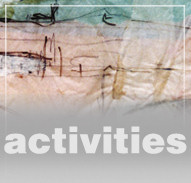Thursday 04 September 2025 9:00 PM - Verziere delle Monache Park, Via C. Sforza ... > read more  Wednesday 08 October 2025 at 9 p.m. – Gottarelli Foundation hall – " Where the ... > read more
|
|
|
|
|
|
|
|
|
|
Activities
 |
"In a single glance"Meeting at the Foundation ..
Lokarock in concert
 Rock 60s-70s-80s
Rock 60s-70s-80s
The Gottarelli Foundation resumes its activities after the summer break with the first appointment scheduled for Thursday 4 September at 9 pm in the Verziere delle Monache Park, Via Caterina Sforza 5 in Imola, entitled "Lokarock in concert" with the Lokarock group. A musical journey will be proposed that will give life to a concert with a pleasant and interesting repertoire. A musical evening with great Italian successes mainly from the 60s / 70s and 80s.
Performed by: Alfredo Federici - guitar and vocals; Liliano Federici - guitar and vocals; Vincenzo D'Errico - vocals; Luigi Gambetti - drums; Massimo Mazzotti - keyboards; Luigi Sasdelli - Bass
The group was formed in the early 2000s and has arrived at a line-up that includes elements of proven experience in the musical field. They have always played great hits from the 60s/70s/80s, Italian and international, with the desire to relive together with the public those emotions that each of us had felt when those songs were in the charts.
Their repertoire is made up of covers from the 60s to today, passing from Nomadi to Battisti, from Zucchero to Pooh, to get to the Beatles to C C.R., Winehouse, Dylan and many others ...
So these immortal melodies take on new life in a unique show.
Entrance by donation
WHERE DID THE ILLUSTRIOUS IMOLA PEOPLE LIVE?
 Conversation through Images with Liliana Vivoli
Conversation through Images with Liliana Vivoli
The appointment on Wednesday 8 April at 9 pm, in the Sala Fondazione Gottarelli, Via Caterina Sforza 13 in Imola, is dedicated to the discovery of the historical and cultural excellences of Imola and is entitled: "Where did the illustrious Imola people lived", by Dr. Liliana Vivoli.
It will be an opportunity to share ideas, get to know and explore places in an original way, immerse yourself in history, art and architectural beauty and enhance our territory rich in history, art and charm.
Almost always, in a hurry, we pass through old doors unaware of those who have crossed them in the past, we glance at windows without wondering who once looked out of them.
So, let's try to look around with more attentive eyes: from the noble palaces (Macchirelli, Casoni, Monsignani etc.) to the most modest houses, every place has something to tell us about the people who lived their daily lives there in the past, who left a trace of themselves there. We will therefore take a virtual walk through the streets of Imola in search of them, offering the participants of the evening a dynamic and quality overview and we are sure that we would be able to make the Imola heritage usable.
Free admission

The Martians in San Prospero
 So many things happened in Imola and its surroundings
So many things happened in Imola and its surroundings
On Wednesday 12 November at 9 pm, Antonio Castronuovo presents his new book "Cento fatterelli d'Imola e dintorni" (ED. Il Nuovo Diario Messaggero).
History is also made up of small events, many of which are curious, even comical. And so, Castronuovo wanted to collect one hundred of these episodes in his latest book: One hundred fattelelli d'Imola and surroundings. A kaleidoscope of facts, more or less recent, that really happened: facts young and old, all curious, narrated with an ironic and cordial pen.
In a fun and smiling evening, Castronuovo will tell us how the Martians landed one day in San Prospero, how the scientist Ighina paralyzed the City Council with a green ray, the arrival in Imola of the scandalous film "Helga", Pompilio's grattachecca, Bagaretta called "lo strapazoun", etcetera etcetera!
BIOGRAPHICAL NOTE OF THE AUTHOR
Antonio Castronuovo is an essayist, translator and bibliophile. He is in the editorial offices of the main Italian magazines of book culture and writes for the "Gazzetta di Parma". He is on the board of the Aldus Club of Milan, the largest Italian bibliophile association. He directs various editorial series for the publishers Pendragon and La Mandragora. His latest works: Dizionario del bibliomane (Sellerio), Il male dei fiori: Baudelaire a processo (Rubbettino), Formíggini. Humorous (and tragic) life of a publisher of the '900 (Pendragon). A book he has edited, in several voices, on the theme of bibliophilia is being published these days by La Nave di Teseo. In 2022 he received the National Award for Translation from the Ministry of Culture; in 2023 the Manara Valgimigli prize for the complex of his intellectual activity.
Free admission
|
|
|
|
|
|
|
|
|
|
|
|

